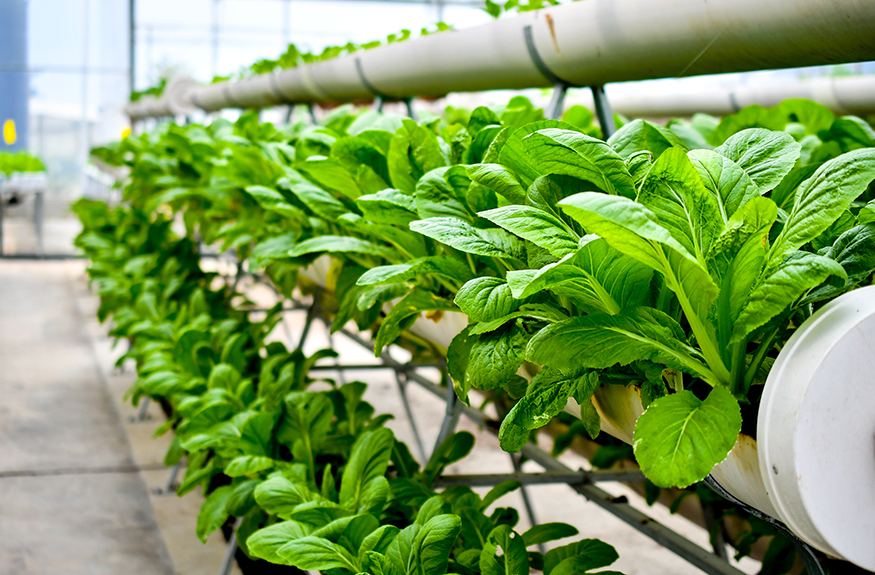Vertical Farming Methods in Commercial Real Estate
In recent years, commercial real estate owners and managers have been moving toward environmental sustainability systems that are cost-effective and beneficial to tenants and staff. One of these systems is rooftop gardens, which are kickstarting a wider shift towards sustainable urban farming. Some properties do not have the luxury of a large space they can dedicate to a garden but with vertical farming techniques, it takes only a few square feet to grow fresh produce on-site for tenants, staff, and guests.
Urban Farming Technology
Hydroponic, aquaponic, and aeroponic farming technologies are all methods of vertical farming used in urban landscapes. All three of these techniques differ from conventional farming due to their lack of soil. These techniques are time and yield efficient while using a fraction of the resources required for conventional farming.
Hydroponic
Hydroponic urban farming systems use submersion techniques in nutrient rich water to provide the plants will all the necessary elements for growth. With the submersion techniques, the roots of the plant are fully under water to soak up the most nutrients. In this method, plants also pull nutrients from the air. Hydroponics are different than conventional farming because there is no soil involved in the plant growth. Instead, a growth medium such as coconut coir, perlite, rockwool, polymer composites, and more are used as the basis for plant growth. Different types of growth mediums provide different benefits like organic versus reusable.
A few plants that thrive in hydroponic systems include:
- Beans
- Blueberries
- Mint
- Bok Choy
- Dill
Aquaponic
Aquaponic urban farming uses similar submersion techniques to hydroponic systems. The plant roots are fully underwater in a container, but they are connected to another container containing live fish as their growth medium. Aquaponic techniques utilize the nutrients from live fish waste to grow plants. This setup recirculates water throughout the system to foster a symbiotic relationship between the fish and the plants. This method avoids the need to manually administer nutrients because the fish provide plenty for plant growth. Fish waste fertilizes the plants, and the plants control the excess ammonia in the water, thus creating a suitable environment for the fish.
A few plants grown effectively in aquaponic systems include:
- Ginger
- Cauliflower
- Peppers
Aeroponic
Aeroponic urban farming systems include suspending plants in air with their roots exposed to a sprinkler system that sprays nutrient rich water directly to their roots. Aeroponic systems thrive because of the consistent exposure to oxygen which allows plants to retain plenty of nutrients from the air and water solution. While this system can be expensive because of the sprinkler system needed, it produces extremely fast and high yields because of the nutrient exposure.
A few plants grown best in aeroponic systems include:
- Brussel Sprouts
- Pumpkins (and other gourds)
- Okra
- Melons (like Watermelon or Cantaloupe)
Systems Overlap in Sustainability
Hydroponic, aquaponic, and aeroponic systems can be used to grow a number of the same plants. These include:
- Lettuce (and other leafy greens such as spinach and kale)
- Tomatoes
- Cucumbers
- Basil
- Strawberries
In urban areas, readily available nutrient rich soil can be rare, and technologies that make soil obsolete are critical towards expanding urban farming. Available green space is no longer required for adequate farming techniques in commercial real estate. These techniques require maintenance but are more sustainable and efficient than conventional farming.
Many vertical gardens and farms are housed indoors lowering the impact of different climate obstacles. Indoor farming allows for increased flexibility in where these systems are housed. Their vertical nature also saves space and can be adjusted to meet various measurement allocations.
Vertical farming can act as another added amenity for tenants in commercial properties. Tenants could have access to fresh produce regularly and learn about the produce they receive. Pairing educational opportunities with these vertical farming programs can allow for an excellent tenant education event, similar to how the production of honey in urban beehives for tenants is a great way to open discussions on the importance of pollinators.
“It’s a growing area” explains Mary Kay Woodworth, Executive Director of the Georgia Urban Agriculture Council “I have also seen vertical farming incorporated in a commercial property on rooftops where a company is growing fruits and vegetables for their tenants as just another added benefit.”
Industrial Real Estate Application
Vertical farming can thrive indoors and outdoors allowing more versatility in location. Vertically farmed produce can survive in multiple property types from industrial to commercial offices. In industrial property there is plenty of space for large vertical farming systems that can be kept indoors because soil and sunlight have become obsolete in these technologies. In commercial offices, vertical farming systems can be housed on rooftops, courtyards, lobbies, and other available spaces.
Vertical farming techniques like hydroponics, aeroponic, and aquaponics are a growing field in agriculture that can also enhance commercial properties. These techniques require little space and can be located anywhere space allows. Vertical farming is an excellent amenity and sustainable option to explore at your property.
To stay up to date on news and resources such as this and other topics of importance to the real estate industry, subscribe to the free CRE Insight Journal Newsletter using this link.
Sources:
- Mary Kay Woodworth, Executive Director of the Georgia Urban Agriculture Council
- Urban Farming Takes Root in CRE | Singapore | Cushman & Wakefield (cushmanwakefield.com)
- What’s The Difference: Hydroponics Vs. Aquaponics Vs. Aeroponics | Origin Hydroponics
- Top 9 Best Vegetables To Grow In Hydroponics (with pictures) – The Hydroponics Planet
- The 50 Best Hydroponic Plants to Grow – Pure Greens: Custom Container Farms (puregreensaz.com)
- Best Plants for Aquaponics – The good, the Bad, and the Ugly – HowtoAquaponic
- What Plants Can Be Grown in Aeroponics? 19 Plants You Never Considered – Small Scale Gardener









